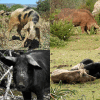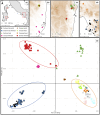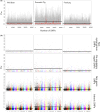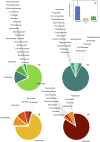Population genomic, olfactory, dietary, and gut microbiota analyses demonstrate the unique evolutionary trajectory of feral pigs
- PMID: 34676935
- PMCID: PMC11497273
- DOI: 10.1111/mec.16238
Population genomic, olfactory, dietary, and gut microbiota analyses demonstrate the unique evolutionary trajectory of feral pigs
Abstract
Domestication is an intriguing evolutionary process. Many domestic populations are subjected to strong human-mediated selection, and when some individuals return to the wild, they are again subjected to selective forces associated with new environments. Generally, these feral populations evolve into something different from their wild predecessors and their members typically possess a combination of both wild and human selected traits. Feralisation can manifest in different forms on a spectrum from a wild to a domestic phenotype. This depends on how the rewilded domesticated populations can readapt to natural environments based on how much potential and flexibility the ancestral genome retains after its domestication signature. Whether feralisation leads to the evolution of new traits that do not exist in the wild or to convergence with wild forms, however, remains unclear. To address this question, we performed population genomic, olfactory, dietary, and gut microbiota analyses on different populations of Sus scrofa (wild boar, hybrid, feral and several domestic pig breeds). Porcine single nucleotide polymorphisms (SNPs) analysis shows that the feral population represents a cluster distinctly separate from all others. Its members display signatures of past artificial selection, as demonstrated by values of FST in specific regions of the genome and bottleneck signature, such as the number and length of runs of homozygosity. Generalised FST values, reacquired olfactory abilities, diet, and gut microbiota variation show current responses to natural selection. Our results suggest that feral pigs are an independent evolutionary unit which can persist so long as levels of human intervention remain unchanged.
Keywords: Sus scrofa; diet; feralisation; gut microbiota; olfaction; population genomics.
© 2021 The Authors. Molecular Ecology published by John Wiley & Sons Ltd.
Conflict of interest statement
The authors declare no conflicts of interest.
Figures






Similar articles
-
Reprogramming of the gut microbiota following feralization in Sus scrofa.Anim Microbiome. 2023 Feb 24;5(1):14. doi: 10.1186/s42523-023-00235-x. Anim Microbiome. 2023. PMID: 36823657 Free PMC article.
-
Phenotype and animal domestication: A study of dental variation between domestic, wild, captive, hybrid and insular Sus scrofa.BMC Evol Biol. 2015 Feb 4;15(1):6. doi: 10.1186/s12862-014-0269-x. BMC Evol Biol. 2015. PMID: 25648385 Free PMC article.
-
Molecular microevolution and epigenetic patterns of the long non-coding gene H19 show its potential function in pig domestication and breed divergence.BMC Evol Biol. 2016 Apr 23;16:87. doi: 10.1186/s12862-016-0657-5. BMC Evol Biol. 2016. PMID: 27107967 Free PMC article.
-
Genetic resources, genome mapping and evolutionary genomics of the pig (Sus scrofa).Int J Biol Sci. 2007 Feb 10;3(3):153-65. doi: 10.7150/ijbs.3.153. Int J Biol Sci. 2007. PMID: 17384734 Free PMC article. Review.
-
Mining the pig genome to investigate the domestication process.Heredity (Edinb). 2014 Dec;113(6):471-84. doi: 10.1038/hdy.2014.68. Epub 2014 Jul 30. Heredity (Edinb). 2014. PMID: 25074569 Free PMC article. Review.
Cited by
-
Genome-Wide Selection Signal Analysis to Investigate Wide Genomic Heredity Divergence between Eurasian Wild Boar and Domestic Pig.Animals (Basel). 2023 Jun 30;13(13):2158. doi: 10.3390/ani13132158. Animals (Basel). 2023. PMID: 37443955 Free PMC article.
-
Multi-Omics Analysis of Gut Microbiota and Sperm Quality in Tibetan Breeding Boars.Metabolites. 2025 Jul 2;15(7):447. doi: 10.3390/metabo15070447. Metabolites. 2025. PMID: 40710546 Free PMC article.
-
Impact of feralization on evolutionary trajectories in the genomes of feral cat island populations.PLoS One. 2024 Aug 13;19(8):e0308724. doi: 10.1371/journal.pone.0308724. eCollection 2024. PLoS One. 2024. PMID: 39137187 Free PMC article.
-
Reprogramming of the gut microbiota following feralization in Sus scrofa.Anim Microbiome. 2023 Feb 24;5(1):14. doi: 10.1186/s42523-023-00235-x. Anim Microbiome. 2023. PMID: 36823657 Free PMC article.
-
Population structure and hybridisation in a population of Hawaiian feral chickens.Heredity (Edinb). 2023 Mar;130(3):154-162. doi: 10.1038/s41437-022-00589-z. Epub 2023 Feb 1. Heredity (Edinb). 2023. PMID: 36725960 Free PMC article.
References
-
- Abe, T. (2021). Impacts by feral goats on critically endangered Crepidiastrum grandicollum (Compositae) endemic to the Ogasawara Islands. Plant Species Biology, 36(2), 361–367. 10.1111/1442-1984.12314 - DOI
-
- Albarella, U. , Manconi, F. , & Trentacoste, A. (2011). A week on the plateau: Pig husbandry, mobility and resource exploitation in central Sardinia. In Albarella U., & Trentacoste A. (Eds.), Ethnozooarchaeology. The present and past of human‐animal relationships (pp. 143–159). Oxbow Books.
-
- Albarella, U. , Manconi, F. , Vigne, J. D. , & Rowley‐Conwy, P. (2007). Ethnoarchaeology of pig husbandry in Sardinia and Corsica. Pigs and Humans, 10, 285–307.
-
- Allwin, B. , Swaminathan, R. , Mohanraj, A. , Suhas, G. N. , Vedaminckam, S. , Gopal, S. , & Kumar, M. S. (2016). The Wild Pig (Sus scrofa) Behavior – A Retrospective Study. Journal of Veterinary Science & Technology, 7, 333. 10.4172/2157-7579.1000333 - DOI
Publication types
MeSH terms
Grants and funding
LinkOut - more resources
Full Text Sources
Other Literature Sources
Miscellaneous

